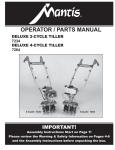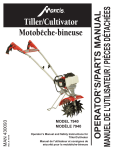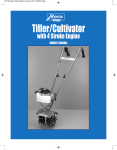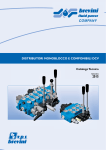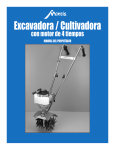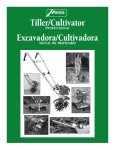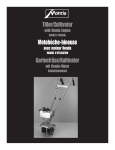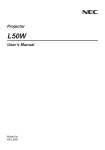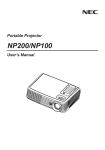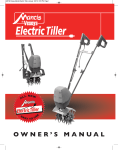Download Mantis 7945 Operator`s manual
Transcript
MODEL 7945 Operator’s Manual and Safety Instructions for Tiller/Cultivator OPERATOR’S/PARTS MANUAL Rev. B 9-11-14 MAN 430099 Tiller/Cultivator Welcome to the World of Mantis Gardening Here’s your new MANTIS Tiller . . . the lightweight wonder that’s Changing the Way Americans Garden.® ATTENTION MANTIS PRODUCT OWNERS! Unlike big tillers, your MANTIS Tiller weighs only 22 lbs. (Model 7945). So it lifts Get maintenance tips for your Mantis easily, handles smoothly, tills and weeds precisely. And, unlike other small tillers, product on our web site it features serpentine tines that churn soil to ten inches deep. It creates a soft, at www.mantis.com smooth seed bed, even in problem soil. Once you know how to use your tiller correctly, we guarantee you’ll love it. So first, please read this manual. It shows, step by step, how to use your tiller safely. IMPORTANT MESSAGE Thank you for purchasing this Schiller Grounds Care, Inc. product. You have purchased a world class product, one of the best designed and built anywhere. This machine comes with Operation and Safety instructions, Parts and Service instructions and Engine instructions. The useful life and good service you receive from this machine depends to a large extent on how well you read and understand these manuals. Treat your machine properly, lubricate and adjust it as instructed, and it will give you many years of reliable service. Your safe use of this Schiller Grounds Care, Inc. product is one of our prime design objectives. Many safety features are built in, but we also rely on your good sense and care to achieve accident-free operation. For best protection, study the manuals thoroughly. Learn the proper operation of all controls. Observe all safety precautions. Follow all instructions and warnings completely. Do not remove or defeat any safety features. Make sure those who operate this machine are as well informed and careful in its use as you are. See a Schiller Grounds Care, Inc. dealer for any service or parts needed. Schiller Grounds Care, Inc. service ensures that you continue to receive the best results possible from Schiller Grounds Care, Inc. products. You can trust Schiller Grounds Care, Inc. replacement parts because they are manufactured with the same high precision and quality as the original parts. Schiller Grounds Care, Inc. designs and builds its equipment to serve many years in a safe and productive manner. For longest life, use this machine only as directed in the manuals, keep it in good repair and follow safety warnings and instructions. You’ll always be glad you did. Schiller Grounds Care, Inc. 1028 Street Road Southampton, PA 18966-4217 PHONE (800) 366-6268 • FAX (215) 956-3855 TABLE OF CONTENTS SAFETY RULES & WARNINGS Special Safety Information������������������������������������������������� 3 Safety & Warnings������������������������������������������������������������� 3 Safety Decal Information��������������������������������������������������� 3 Warning Dos���������������������������������������������������������������������� 4 Warning Don’ts������������������������������������������������������������������ 5 Engine/Fuel Warning Dos�������������������������������������������������� 5 Engine/Fuel Warning Don’ts���������������������������������������������� 5 ASSEMBLY���������������������������������������������������������������������������� 6 Lower Handle�������������������������������������������������������������������� 7 Upper Handle Assembly���������������������������������������������������� 8 Kickstand��������������������������������������������������������������������������� 8 Tines���������������������������������������������������������������������������������� 9 FUELING & STARTING 4-Cycle Fueling & Oil Only���������������������������������������������� 10 4-Cycle Starting Only������������������������������������������������������� 11 4-Cycle What to Do Just in Case�������������������������������� 11-12 OPERATION��������������������������������������������������������������������13-14 TRANSPORTATION������������������������������������������������������������� 15 STORAGE���������������������������������������������������������������������������� 15 MAINTENANCE��������������������������������������������������������������16-18 TROUBLESHOOTING��������������������������������������������������������� 19 ENGINE MAINTENANCE SCHEDULE�������������������������������� 20 MANTIS TILLER ASSEMBLY & PARTS LIST�����������������21-22 EMISSION CONTROL WARRANTY������������������������������������ 23 LIMITED WARRANTY INFORMATION����������������BACK PAGE This Operator’s / Parts Manual is part of the machine. Suppliers of both new and second-hand machines must make sure that this manual is provided with the machine. 2 Operator’s Manual Safety Rules & Warnings You will notice throughout this Operator’s Manual Safety Rules and Important Notes. Make sure you understand and obey these warnings for your own protection. I. SPECIAL SAFETY INFORMATION Attention: This symbol points out our important safety instructions. When you see this symbol, heed it’s warning!! Stay alert!! To reduce the potential for accidents, comply with the safety instructions in this manual. Failure to comply may result in serious personal injury, and/or equipment and property damage. II. SAFETY & WARNINGS Improper use or care of this tiller or failure to wear proper protection can result in serious injury. Read and understand the rules for safe operation and all instructions in this manual. Wear hearing and eye protection. The engine exhaust from this product contains chemicals known to the State of California to cause cancer, birth defects or other reproductive harm. III. SAFETY DECAL INFORMATION An important part of the safety system incorporated in this tiller are the warning and information decals found on various parts of the tiller. These decals must be replaced in time due to abrasion, etc. It is your responsibility to replace these decals when they become hard to read. P/N 430057 Cutting hazard; keep feet and hands away from rotating tines. Do not carry the tiller in this position. Wear ear and eye Protection. Read owner’s manual before using tiller, or performing any repair or maintenance. Keep owners manual in a safe place. Caution: when assembling the handles, make sure fuel tank faces away from operator. This is the rear of the tiller, refer to assembly instruction on page 7-8. Don’t operate indoors Don’t fuel, refuel, or check fuel while smoking, or near an open flame or other ignition source. Incorrect assembly. P/N 400631 Fuel is extremely flammable. Stop engine and be sure it is cool before fueling Keep away from ignition source. Contact us at www.mantis.com 3 If the tiller is used improperly or safety precautions are not followed, the users risk serious injury to themselves and others. Read and understand this manual before attempting to operate this tiller. IV. WARNINGS - DOS Read and understand the owner’s manual. Pay particular attention to all sections regarding safety. 1. Always keep a firm grip on both handles while the tines are moving and/or the engine is running. BE AWARE!! The tines may coast after throttle trigger is released. Make sure tines have come to a complete stop and engine is off before letting go of the tiller. 2. Always maintain a firm footing and good balance. Do not overreach while operating the tiller. Before you start to use the tiller check the work area for obstacles that might cause you to lose your footing, balance or control of the machine. 3. Thoroughly inspect the area where equipment is to be used and remove all objects, which can be thrown by the machine. 4. Always keep area clear of children, pets, and bystanders. 5. Always stay alert. Watch what you are doing and use common sense. Do not operate unit when fatigued. 6. Always dress properly. Do not wear loose clothing or jewelry, they might get caught in moving parts. Use sturdy 4 Operation of this equipment may create sparks that can start fires around dry vegetation. A spark arrestor is installed. The operator should contact local fire agencies for laws or regulations relating to fire prevention requirements. gloves. Gloves reduce the transmission of vibration to your hands. Prolonged exposure to vibration can cause numbness and other ailments. 7. While working, always wear substantial footwear and long trousers. Do not operate the equipment when barefoot or wearing open sandals. 8. Always wear ear and eye protection. Eye protection must meet applicable CE requirements. To avoid hearing damage, we recommend hearing protection be worn whenever using the equipment. 9. To reduce fire hazard, keep the engine, and petrol/gas storage area free of vegetative material and excessive grease. 10. Start the engine carefully, according to the manufacturer’s instructions and with feet well away from tool(s). 11. Keep all nuts, bolts and screws tight to be sure the equipment is in safe working condition. 12. Use extreme caution when reversing or pulling the machine towards you. 13. Work only in daylight or good artificial light. Operator’s Manual 14. Always be sure of your footing on slopes. 15. Exercise extreme caution when changing direction on slopes. 16. Always keep a safe distance between two or more people when working together. 17. Always inspect your unit before each use. Keep all knobs, nuts, bolts and screws tight to be sure the equipment is in safe working condition. 18. Always visually inspect to see that the tools are not worn or damaged. Before using your tiller, replace worn or damaged elements and bolts in sets to preserve balance. 19. Always maintain and examine your Tiller with care. Follow maintenance instructions given in manual. 20. Always store tiller in a sheltered area (a dry place), not accessible to children. The tiller as well as fuel should not be stored in a house. 21. Always keep in mind that the operator or user is responsible for accidents or hazards occurring to other people or their property. Safety Rules & Warnings V. WARNINGS - DON’TS Don’t use tiller with one hand. Keep both hands on handles with fingers and thumbs encircling the handles, while tines are moving, and engine is running. Don’t run with the machine, walk. Don’t work on excessively steep slopes. Don’t attempt to clear tines while they are moving. Never try to remove jammed material before switching the engine off and making sure the tines have stopped completely. Don’t allow children or people unfamiliar with these instructions to use the machine. Local regulations can restrict the age of operator. Don’t let others operate tiller without proper training. Don’t operate while under the influence of alcohol or drugs. Don’t attempt to repair this tiller. Have repairs made by a qualified dealer or repairman. See that only original Mantis parts are used. Don’t overreach. Keep a good footing at all times. Don’t stand in front of tiller when tines are rotating. Handle fuel with care, it is highly flammable. Fueling a hot engine or near an ignition source can cause a fire and result in serious personal injury and/or property damage. VI. ENGINE/FUEL WARNINGS - DOS Always use fresh gasoline. Stale gasoline can cause damage. Always store fuel in containers specifically designed for this purpose. Always add fuel before starting the engine. Always replace all fuel tank and container caps securely. Always pull starter cord slowly until resistance is felt to avoid kickback and prevent arm or hand injury. Always operate engine with spark arrestor installed and operating properly. Stop the engine whenever you leave the machine and before refueling. Allow the engine to cool before storing in any enclosure. Replace worn or damaged parts for safety. If the fuel tank needs to be drained, this should be done outdoors. VII. ENGINE/FUEL WARNINGS - DON’TS Never pick up or carry a machine while the engine is running. Don’t fuel, refuel or check fuel while smoking, or near an open flame or other ignition source. Stop engine and be sure it is cool before refueling. Don’t leave the engine running while the tiller is unattended. Stop the engine when carrying out maintenance and cleaning operations, when changing tools and when being transported by means other than under its own power. Never remove the cap of the fuel tank or add fuel while the engine is running or when the engine is hot. Don’t refuel, start or run this tiller indoors or in an improperly ventilated area. Don’t run engine when electrical system causes spark outside the cylinder. During periodical checks of the spark plug, keep plug a safe distance from cylinder to avoid burning of evaporated fuel from cylinder. Don’t check for spark with spark plug or plug wire removed. Use an approved tester. Don’t crank engine with spark plug removed unless spark plug wire is disconnected. Sparks can ignite fumes. Don’t run engine when the odor of gasoline is present or other explosive conditions exist. Do not attempt to start the engine if fuel is spilled, but move the machine away from the area of spillage and avoid creating any source of ignition until fuel vapors have dissipated. Contact us at www.mantis.com Don’t operate your tiller if there is an accumulation of debris around the muffler, and cooling fins. To reduce the fire hazard, keep the engine and fuel storage area free of vegetative material and excessive grease. Don’t touch hot mufflers, cylinders or cooling fins as contact may cause serious burns. Don’t change the engine governor setting or over speed the engine. Don’t attempt to remove spark plug while engine is hot. Removing a spark plug from a hot engine can cause irreparable damage to the engine and will void your warranty. Don’t use starter fluids as they will cause permanent engine damage. 5 Assembly Picture of Model 7945 T21 T20 T46 Improper assembly of this tiller can result in serious injury. Make sure to follow all instructions carefully. If you have any questions, contact our factory at 1-800-366-6268 or an authorized Mantis dealer. Bag Contents T40 T12 T39 T9 T41 T11 T4 T42 T15 T2 T1 T14 T3 T15 T42 T13 T11 T7 T14 T9 T7 T12 If your tiller comes with a kickstand, your box will also include: Key Qty. T1 1 Upper Handle Throttle Side Assembly T2 1 Upper Handle Assembly, Left T3 2 Lower Handles W/Plug T4 1 Handle Brace Assembly T10 1 Plastic Carrying Handle T21, T20, T46 1 Engine Assembly (includes Fender Guard & Worm Gear Transmission) T39/T40 1 Pair Tiller/Cultivator Tines 1 Bag of Hardware T7 2 Handle Clamps T9 1 Throttle Clip T11 2 Bolts (3” long) T12 2 Knobs T13 2 Acorn Nuts T14 4 Lock Nuts T15 2 Cap Screws T41 2 Tine Retaining Pins T42 2 Carriage Bolts Not Shown 1 6 400206 T41 T10 WHAT COMES IN THE BOX Part No. T13 Description 4-Cycle Oil T52 Part No. T53 Key Qty. T52 1 Kickstand Assembly Description T53 1 Kickstand Bracket & Hardware Bag WHAT YOU WILL NEED TO ASSEMBLE THE TILLER Prior to removing the contents and assembling, it is important to: • Have a clean work area. • You will need two 7/16” wrenches • Make sure all necessary tools are handy. • A 3/8” wrench for kickstand assembly (if included) Operator’s Manual Assembly LET’S BEGIN • With the box upright, open the box and remove the tine box and the loose parts that are at the top of the tiller box. Do not remove any other parts in the box. • Lay the box on one side and open the bottom flaps. • Return the box to an upright position (as shown) and pull the box straight up. • Leave the engine and throttle handle in the cradle to assist in the assembly. • Lay everything out so you can easily identify the parts (see parts image and list on page 6). LOWER HANDLE ASSEMBLY NOTE: Some of the photos in this manual do not represent your tiller engine. They are for assembly purposes only. To identify part numbers see page 6. 1 2 3 4 • For ease of assembly and stability it is important that you keep the engine assembly in its cardboard cradle. • Lay the handle parts within easy reach. You’ll need one of the handle clamps (T7) and one of the lower handles (T3). Note that the lower handles have a short leg on one end. • Choose one of the two 3-inch bolts (T11). Slide it through the first set of holes — near the elbow where the lower handle curves. (Pictures 2 & 3) • Locate recessed channels below the engine. •F it the handle clamp along the outside of the short leg. Line up the holes on the clamp and the leg. 5 • Take the lower handles that you’ve just put together. Slide them into the two recessed channels. • Now slide the other lower handle onto the 3-inch bolt. Fit the other clamp onto the other handle’s short leg. Add a lock nut (T14) and tighten finger tight. (Picture 3) 6 • Make sure you insert them from the rear of the tiller (gasoline tank faces away from the operator)... so that the bolt fits along the back of the housing. • Slide the second 3-inch bolt (T11)through the second set of holes in the short legs. Add a lock nut (T14) and tighten finger tight until you’ve completed assembly. NOTE: THE LOCK NUTS ARE STAMPED. FINGER TIGHT IS APPROXIMATELY 1/2 TO 1-1/2 TURNS UNTIL YOU’VE COMPLETED ASSEMBLY. Contact us at www.mantis.com 7 Assembly (Continued) UPPER HANDLE ASSEMBLY 7a • Lightly squeeze the lower handles (T3) toward one another so that they line up with the two smaller holes on the carrying handle (T10). Then slide the carrying handle over and down the lower handles. It will rest about four to six inches above the fender. • Gently pull the lower handles out to their original position. 8 9 • Lift the upper handle until it lines up with the lower handle. • Insert carriage bold (T42) from outside in. • Screw on knob (T12) and fully tighten the knob at the pivot point. • Cap the exposed bolt with an acorn nut (T13) and tighten with your 7/16” wrench until snug. Do not over tighten. 11 10 7b • Your Mantis Tiller will look like this when the lower handle assembly is complete. • Follow the same steps to install the other upper handle onto the other lower handle. • Use the clip (T9) to secure the throttle cable and wire in place on the lower handle. • Now install the handle brace. Line it up with the holes on the upper handles. Then insert a cap screw (T15) and a lock nut (T14) on either side. • Use a wrench to tighten cap screws and lock nuts. • Now use wrench to tighten all nuts and bolts firmly and securely. KICKSTAND ASSEMBLY (If your tiller comes with a kickstand) 1 2 • Position the kickstand brace just above the bend of the lower handles. • Position the kickstand under the lower handles, line up the holes and thread the kickstand brace bolts into the kickstand. •Tighten with the 3/8” wrench. 8 Operator’s Manual 3 • Your Mantis tiller will look like this when lower handle assembly and kickstand is complete. Assembly (Continued) TINE ASSEMBLY 1 2 3 • Remove the unit from the cardboard cradle and lay the unit on its side. • You’ll need the 2 Tines and the 2 retaining pins. 4 5 • Attach the Tine so that the circular hole slides onto the axle first. • You will notice that one side of the Tine has a circular hole while the other has a “D” shaped hole. 6 • When the axle protrudes from the other side it will line up perfectly with the “D” shaped hole. IMPORTANT NOTE: Make sure you have installed the handles properly. When you stand behind your tiller, holding the handles, the fender warning label should face you. IMPORTANT NOTE: Before you use your MANTIS Tiller, read the Safety Rules & Warnings on pages 3-5 IMPORTANT NOTE: 7945 Improper Throttle installation can cause tines to rotate unexpectedly. Be sure you have proper throttle movements and that the throttle cable is not wrapped or twisted around the handle bar. Hold down the lockout lever, fully squeeze the throttle trigger and let go. The throttle triangle must click in both directions. If there is any doubt, remove air filter and visually check that the throttle triangle hits both the idle screw and the full open stop. THIS MUST BE DONE BEFORE STARTING THE ENGINE. Contact us at www.mantis.com 9 4-Cycle Tiller Fueling & Starting 4-CYCLE TILLER FUELING AND OIL ONLY ENGINE FEATURES IMPORTANT! It is normal for your 4 stroke engine to smoke for the first minute or two of operation, however it is not necessary for this to occur every time. This is a result of the oil being pulled through the engine for lubrication. • Rock the tiller forward so that it rests on the fuel tank. • It is important to position the Mantis 4-Cycle Tiller as shown in Figure 1 so the oil will properly fill the crankcase. Failure to do so will cause engine damage. Starter Grip Recoil Starter Top Cover Fuel Tank Choke Lever Fuel Filler Cap Air Cleaner Priming Bulb Figure 1 • Remove the oil plug. • Pour in 2.7 fl. oz. of approved, 4-cycle engine oil. Use 4-stoke motor oil that meets or exceeds the requirements for API service classification SJ or later (or equivalent). Always check the API service label on the oil container to be sure it includes the letters SJ or later (or equivalent). SAE 10W-30 is recommended for general use. Oil Filler Cap/ Dipstick • Always check the oil level before each use. The oil level should reach the inner first thread of the reservoir. Do not overfill. Spark Plug (inside the top cover) Muffler (inside the top cover) • Replace the oil plug. • Then return the unit to the upright position. Fueling your Mantis 4-Cycle Tiller/Cultivator is easy. Unscrew the gas cap and fill the tank about four-fifths of the way up with 89 octane unleaded gasoline. And remember, always drain the gas when transporting the unit from one location to another. Throttle Lever ! WARNING • DANGER ! ALTERNATIVE FUELS, SUCH AS E-15 (20% ETHANOL), E-85 (85% ETHANOL) OR ANY FUELS NOT MEETING MANTIS REQUIREMENTS ARE NOT APPROVED FOR USE IN GASOLINE ENGINES. USE OF ALTERNATIVE FUELS MAY CAUSE PERFORMANCE PROBLEMS, LOSS OF POWER, OVERHEATING, FUEL VAPOR LOCK AND UNINTENDED MACHINE OPERATION, INCLUDING, BUT NOT LIMITED TO, IMPROPER CLUTCH ENGAGEMENT. ALTERNATIVE FUELS MAY ALSO CAUSE PREMATURE DETERIORATION OF FUEL LINES, GASKETS, CARBURETORS AND OTHER ENGINE COMPONENTS. Do not operate the engine in a confined space where dangerous carbon monoxide fumes can collect. 10 Min IMPORTANT NOTE: Check the oil level in the engine before each use. If oil is low see information above for details. Fuel is extremely flammable. Handle it with care. Keep away from ignition sources. Do not smoke while fueling your equipment Operator’s Manual Max Avoid accidental blade engagement. Do not squeeze the throttle trigger when starting. Maintain proper idle speed adjustment (4100±3100 RPM) 4-Cycle Tiller Fueling & Starting 4-CYCLE TILLER STARTING ONLY WHAT TO DO JUST IN CASE Cold Starting If you follow the normal starting procedure, you should have no problem starting your tiller. But, just in case you do have problems, here’s what to do. • First, make sure the start/stop switch, located on the throttle handle, is in the start position, which is indicated by the “I” symbol. • Close the choke by moving the choke lever to the “Closed” position. Make sure the O/I switch is on “I” (start).You’d be surprised how many people forget to push the switch into the “I” (start) position. WHAT TO DO JUS If the switch was on “O” (stop) when you pulled the cord, you may have flooded the engine. OFF Open ON Close Choke Lever ! WARNING ! MAKE SURE THE START/ STOP SWITCH IS IN THE STOP POSITION. KEEP PLUG WIRE AWAY FROM ENGINE TO AVOID UNINTENTIONAL SPARK. Switch • Press the primer bulb approximately 10-15 times until he bulb is filled with gas. Once it is filled, press it two more times. • Pull handle trigger 4 times. • Pull the starter cord lightly until you feel resistance and then give it a short, brisk pull. Your tiller should start. Do not pull the cord all the way out and do not let it snap back into the starter housing. NOTE: DO NOT PULL THE CORD MORE THEN 4 TIMES WHEN THE CHOKE IS CLOSED. OVER PULLING MAY CAUSE ENGINE FLOODING. Bear in mind that , when the engine fires, it only coughs or sputters, and will not run on choke. • Once it is running, open the choke. Ensure the lever is fully down • To stop the engine, simply push the start/stop switch to the stop position “O.” Warm Starting • Leave the choke lever in the “Open” position. • Pump the primer bulb and pull the starter rope • Before using the tiller, let the engine run for a minute to warm up. And before shutting it down, let the engine run briefly to cool down. Re-Fueling • Follow “Cold Starting” procedure when refilling empty gas tank. Never use starting fluids as they will cause permanent engine damage. Using them will void the warranty. Before you use the tiller, read the Safety & Warning rules on pages 3-5. sta ha til ha IMPORTANT NOTE: To avoid possible damage to the threads, do not try to remove the plug from a hot aluminum cylinder head. sw su for “st • First, examine the spark plug. wh ma Picture 1 STARTING A FLOODED ENGINE If the end of the spark plug is wet, the engine may be flooded. Make sure the switch is in the “O” (stop) position, remove top cover, disconnect spark plug wire and remove plug (Picture 1). Use a paper towel or a clean rag to dry the spark plug, then, with the spark plug out of the engine, pull the starter cord several times. Next, replace the spark plug. Use the wrench to tighten it and replace the cap. Then, put the switch in the “I” (start) position and close choke. Follow steps from “Cold Starting” section (page 11). The engine should start and run. M •F U co M # w •R p •U (P Picture 2 Picture 1 FUEL LINES CHECK I T t t h h If the end of the spark plug is dry, check to see if the fuel line is blocked. First loosen the fuel cap to relieve the pressure in the tank. The fuel line runs from the fuel Picture 2 3 tank to the carburetor. Pull it off at Picture the carburetor end. Fuel should drip slowly from the line. Wipe off any excess or spilled fuel. St En If fuel does not drip from the line, check the line for any bends or pinches. (Picture 2). Kinks in the line restrict the 12 flow of fuel to the engine. Contact us at www.mantis.com is flo 11 4-Cycle Tiller Fueling & Starting (Continued) Just straighten out the line. Reconnect. Then follow the normal starting procedure. If fuel drips too freely, the line may be disconnected from the fuel filter. You’ll find the fuel filter inside the fuel tank. Just re-attach the line to the filter, and put the filter back in the tank. Then follow the normal starting procedure. 6. Install the spark plug carefully, by hand, to avoid crossthreading. SPARK PLUG CHECK 9. When reinstalling the original spark plug, tighten 1/8–1/4 turn after the spark plug seats to compress the washer. Recommended Spark Plug: CMR5H (NGK) The recommended spark plug has the correct heat range for normal engine operating temperatures. IMPORTANT NOTE: An incorrect spark plug can cause engine damage. For good performance, the spark plug must be properly gapped and free of deposits. 1. Remove the top cover. Loosen the M5 x 10 hex bolt with a hexagon wrench, then remove the top cover. (Picture 1) 7. After the spark plug is seated, tighten with a 5/8-inch spark plug wrench to compress the sealing washer. 8. When installing a new spark plug, tighten 1/2 turn after the spark plug seats to compress the washer. IMPORTANT NOTE: A loose spark plug can overheat and damage the engine. Overtightening the spark plug can damage the threads in the cylinder head. 10. Attach the spark plug cap to the spark plug. 11. Install the top cover, and tighten the M5 x 10 hex bolt securely with a hexagon wrench. Do no operate the engine when the top cover is removed. Do not pull the recoil starter handle when the top cover is removed. You may be injured from the rotating parts or burned by the muffler. 2. Disconnect the spark plug cap, and remove any dirt from around the spark plug area (Picture 2). 3. Remove the spark plug with a 5/8inch spark plug wrench. 4. Inspect the spark plug. Replace it if damaged or badly fouled, if the sealing washer is in poor condition, or if the electrode is worn. Picture 1 5. Measure the spark plug electrode gap with a wire-type feeler gauge. Correct the gap, if necessary, by carefully bending the side electrode. The gap should be: 0.60–.70 mm (0.024–0.028 in) Picture 2 12 Operator’s Manual 4-Cycle Tiller Operation If engine does not stop when switch is put in the stop position, release the throttle, allow engine to idle. Put the tiller down, and slide the choke lever to the cold start (closed) position. Have product serviced before using. A SPECIAL FEATURE Figure 1 tiller away, let it idle for a minute to give the engine a chance to cool down. (With the idle set properly and the engine running) OPERATION Even when the engine is running, the tines won’t turn unless you squeeze the throttle trigger on the handlebars. When you release the throttle trigger, the tines will stop. With engine running, and both hands on the handles, hold down the throttle lockout trigger (Figure 1), then squeeze the throttle trigger gradually to increase the engine speed and engage the tines. A TIP FOR EXTENDING YOUR ENGINE’S LIFE NOTE: This step must be repeated each time your tiller trigger is released. After you start the engine, let your tiller warm up for two to three minutes before you use it. Then, before you put your Read the instructions carefully. Be familiar with the controls and the proper use of the equipment. NOW YOU’RE READY TO USE YOUR MANTIS TILLER. If you’ve seen other tillers, your MANTIS Tiller may surprise you. It tills best when you pull it backward! You see, when you pull your MANTIS Tiller backward, you give extra resistance to the tines, so they dig deeper. (Figure 2) In addition, when you go backward, you erase your footprints. So your soil stays light and fluffy. With other tillers, by contrast, you walk right over the soil you’ve just tilled, packing it down, so it’s less plantable. RUN YOUR MANTIS TILLER LIKE A VACUUM CLEANER Place your Tiller at the head of the row or area you want to till. Start it up. Then use an easy rocking motion. First, pull your Tiller backward. Then use an easy rocking motion. Again, pull your Tiller backward. Then, let Figure 2 it move forward just a little bit. Then pull it backward again. This will help you till deeper. Keep repeating these steps until you’ve tilled an entire row. Start again on the next row. It’s much like running a vacuum cleaner! (Figure 3) You Can Even Control Depth. For Deeper Tilling: Move your Tiller slowly back and forth, as you would a vacuum cleaner. Work the same area over and over until you’ve dug to your desired depth. (Figure 4) For Shallow Tilling: Switch the tines to the cultivating position. (See page 14 to learn how.) Then move your Tiller quickly over your soil surface. Figure 3 Figure 4 For Big Weeds or Tough Roots: Let your Tiller rock back and forth over the tough spot, until the tines slice through the weed or root. Your MANTIS Tiller Handles Special Tilling Projects: Want to turn part of your lawn into a colorful flower border? Your MANTIS Tiller makes it easy! Just run your Tiller back and forth until the sod begins to break up. Then continue tilling. Your Tiller will chop the clumps of sod until they’re fine. Then, it will work them into the soil. Pretty soon, you’ll have a soft, fresh planting bed. ! WARNING ! ALWAYS MAKE SURE THE HANDLE KNOBS ARE SECURE BEFORE STARTING YOUR MANTIS TILLER. Contact us at www.mantis.com 13 4-Cycle Tiller Operation (Continued) The operator of this tiller is responsible for accidents or hazards occurring to himself, other people or their property. If your tines get jammed or entangled, shut off the engine at once. Remove the obstruction while the engine is off. Never try to remove an obstruction while the engine is running. Serious injury can result. YOUR MANTIS TILLER MAKES WEEDING A PLEASURE! The result? Your Tiller will cut your weeding time in half, and turn a tiresome chore into a pleasure. As a tiller, your MANTIS Tiller works the soil down to 10” (25.4 cm) deep. But, as a cultivator, it gently cultivates the surface, only 2” to 3” (5.09 cm to 7.62 cm) deep. First, you must switch the tines to the weeding, cultivating position. This takes less than a minute. Then, your MANTIS Tiller’s sharp “tine teeth” will slice up those pesky weeds, burying them as you go along. And, since the tines in this position won’t dig too deep, they won’t hurt your plants’ precious root systems. 1. Make sure your Tiller is off. 2.Remove the retaining pins from the tines. 3. Remove the tines from the axle. 4. Place the right-side tine onto the left-side axle. Place the left side tine onto the right-side axle. The “D” hole should be to the outside. 5. Reinsert the pins. Tilling Cultivating To set them for tilling, attach the tines so the points of the blades face forward - away from the operator. The tines’ points will contact the ground first. For cultivating, reverse the tines so that the points of the tines face backward - toward the operator. Now the long flat part of the tine’s blade will contact the ground first. Figure 1 14 HOW TO SWITCH FROM TILLING TO CULTIVATING POSITION (FIGURE 1) Operator’s Manual 4-Cycle Tiller Transportation & Storage 4-CYCLE TILLER TRANSPORTATION Transporting your Tiller is easy. It’s light enough and easy to carry using the carrying handle as seen in Figure 1. Or, with it running, you can walk it by gently squeezing the throttle until it moves at a comfortable pace. Your tiller is easily transported in the back of a car or truck. Be sure to empty the fuel tank (This is crucial)! Then stow your tiller in the trunk of your car or truck. Picture 1 ! WARNING ! Figure 1 NEVER CARRY YOUR TILLER AS THE PERSON IN PICTURE 1 IS DOING. IF YOU DO, YOU WILL SUFFER SERIOUS INJURY. TILLER STORAGE Never store the equipment with fuel in the tank or in an area where fumes may accumulate and breach an open flame or spark Each fall, or before you store your Mantis Tiller for any long period, be sure to take these measures: 1. D o not store your Tiller with fuel still in it. Even under ideal conditions, stored fuel containing ethanol or MTBE can start to go stale in 30 days. And, since stale fuel has a high gum content, it can clog the carburetor, this, in turn, will restrict fuel flow. Therefore, when you’re ready to store your Tiller, or will not be using it for more than 2 weeks, drain the fuel tank completely. 2. N ext, restart the engine to make sure no fuel is left in the carburetor. Then, run the engine until it stops. This will prevent gum deposits, forming inside of the carburetor and possible engine damage. 3. D isconnect spark plug wire and remove the spark plug. Slowly pull the starter cord once. 4. Inspect the spark plug, and if necessary, clean it. If you need to replace it, buy a NGK-CMR5H. 5.Install the spark plug, but leave the spark plug wire disconnected. 6.Wipe the tines with oil or spray them with WD-40, to prevent rusting. 7.Oil the throttle cable and all visible moving parts. (Do not remove the engine cover.) 8. Clean or replace the air filter. 9.Check or replace fuel filter. 10.Check the grease level in the worm gear housing. Add grease if needed. 11.Store your Tiller in an upright position in a clean, dry place. You can store with the handles in an extended position or folded down. To fold the handles down, simply loosen the lower 2-pronged knobs until you can pivot the upper handles down. (Figure 2) Or it can be hung using the handle brace. 12.Do you have fuel left over from last season? Dispose of it properly. Buy fresh oil and gasoline next season. 13.Remove Tilling Tines or attachments and lightly oil tine shaft at least once a year. Figure 2 IMPORTANT: It is important to store your 4-Cycle Mantis Tiller in an upright position. Laying the Tiller on its side will cause the oil to leak out of the engine through the air cleaner case. IMPORTANT: Avoid any orientation that places the top cover (engine head) down -this may allow oil from the crankcase to enter the combustion chamber and cause hard starting or a locked piston. Contact us at www.mantis.com 15 4-Cycle Tiller Maintenance Your 4 Cycle Tiller will require some basic maintenance to keep it performing year after year. If you are storing your tiller for the season or longer than 30 days it is very important to empty the fuel tank to prevent engine damage. Undoubtedly, you will be putting your tiller through rigorous use. Check engine oil level, air filter and fuel filter. Air Filter Dipstick Fuel Filter 4-CYCLE CORRECTIVE ACTION If you suspect the engine is overfilled the following procedure should remove the excess oil from the crankcase and valve cover. If the engine is overfilled, oil will enter the crankcase and it does not simply pour out of the oil fill opening. The excessive oil has to be pumped out as the engine runs. Checking the oil level and draining any excess between multiple 30 second running intervals will bring the oil back to the proper level. 1. Place the engine on a level surface resting flat on the fuel tank and remove the oil fill cap/dipstick. Use a catch basin for any oil that overflows from the oil fill opening. 2. Replace the oil fill cap/dipstick and run the engine for approximately 30 seconds then repeat step one. Continue steps 1 & 2 until oil no longer overflows when the oil fill cap/dipstick is removed. 3. Once the oil level is corrected the engine may continue to smoke while running for several minutes while the residual oil burns off. 16 4-CYCLE PROPER OIL FILL/ LEVEL CHECK POSITION This position does not allow for a proper oil level reading and may cause overfilling. Operator’s Manual Engine must be resting on a flat surface on the fuel tank 4-Cycle Tiller Maintenance (Continued) IMPORTANT: AIR FILTER MAINTENANCE A wet or dirty air filter can affect the way your engine starts, performs, and wears. So, it’s a good idea to check your air filter once a month. If you work in dusty soil, or if you want to be on the safe side — check your filter more often (for instance, before each use). But be sure to replace it at least once a year, in the spring or fall. How to Check, Clean and Change the Air Filter Make sure the filter is “seated” properly in the cover. The filter must fit snugly inside the opening that holds the filter in place. Installing the filter incorrectly will cause engine damage and void the warranty. Fit the cover back over the air cleaner and tighten the knob to secure the cover. IMPORTANT NOTE: Figure 1 Figure 2 A dirty air cleaner will restrict air flow to the carburetor, reducing engine performance. If you operate the engine in very dusty areas, clean the air filter element more often then specified in the Maintenance section. IMPORTANT NOTE: Operating the engine without an air filter element, or with a damaged air filter element, will allow dirt to enter the engine, causing rapid engine wear. This type of damage is not covered by the Limited Warranty 1. The air filter is held in the air cleaner in a black housing on the side of the tiller, behind the gas tank cap. 2. Loosen the knob on the side of the air cleaner cover. (Figure 1) 3. Take off the cover. Make sure to clear plastic tabs on the side 4. The air filter is the dark sponge like material on the inside of the air cleaner. Check whether it is soiled or moist. 5. If the air filter needs to be cleaned or no longer fits properly, simply remove it by carefully peeling it out of the air cleaner. (Figure 2) 6. To clean the air filter a. Clean the filter element in warm soapy water, rinse and allow to dry thoroughly. Or, clean in a non-flammable solvent and allow to dry. b. Dip the filter element in clean engine oil, then squeeze out all excess oil. The engine will smoke when started if too much oil is left in the element. c. Wipe dirt from the air cleaner body and cover, using a moist rag. Be careful to prevent dirt from entering the carburetor. 7. Insert your clean filter inside the air cleaner. IMPORTANT NOTE: Please check the lip on the Air Cleaner Cover. If the lip is chipped or cracked, it should be replaced. This will prevent dirt from being ingested through the carburetor into the inside of the engine. Locking Tabs FUEL FILTER REPLACEMENT The fuel filter should be replaced every year. Open the fuel cap and using the cap retainer you can remove the fuel intake line. The filter is at the end. Hold the fuel line and work the filter out. Then just push the new one back into the tube making sure the clamping wire is up high enough to engage with the stem of the filter. Contact us at www.mantis.com 17 4-Cycle Tiller Maintenance (Continued) HOW TO RESEAT THE FLANGE Figure 1 Figure 2 At some point, you may find that the tines won’t turn when you press the throttle. This may mean the engine isn’t sitting all the way down on the worm gear housing. Perhaps you’ve been using your Tiller for several years. Or perhaps you’ve removed the engine for use with our hedge trimmer attachment, then replaced it. In either case, the flange bolt may have come loose and lifted the engine up. If this happened you’ll notice a gap between the bottom of the engine clutch case and the top of the worm gear housing. (Figure 1) To fix this, loosen the flange bolt. Take the engine off the worm Note how the engine sits all the Note how the engine doesn’t sit all gear housing. Notice the hex head on top of the drive shaft . way down on the transmission. the way down on the transmission. Inside the clutch case, you’ll find the clutch drum. Make sure the hex head lines up with the clutch drum inside the clutch case. If you’ve followed these steps properly, there will be no gap between the clutch case and the worm gear housing. (Figure Then put the engine back on the worm gear housing. Make 2) Make sure you tighten the flange bolt! sure the plastic carrying handle is not under the fuel tank. TRANSMISSION CARE Check the transmission grease level after the first 10 hours of use, then check yearly. With the tines off, remove the transmission plate (Figure 3) and gasket to see if the grease level is up to the plate flange (Figure 4). If it is not, you will need to add lithium zero or lithium one grease. Wipe off any excess grease, replace the transmission gasket and plate. CLEANING THE MUFFLER SCREEN Figure 4 Figure 3 Figure 5 1. R emove the engine cover (Figure 5) 2. D isconnect the spark plug cap from the spark plug. 3. R emove the cotter pin. (Figure 6) 4. R emove the muffler screen. 5. If screen is clogged it needs to be cleaned. use carburetor cleaner, and any brush that is not metal. Brush the screen until you are able to see through it. 6. If the screen remains clogged after attempts at cleaning, it must be replaced. 7. R e-install the muffler screen, spark plug cap and engine cover. Cotter Pin Figure 6 18 Operator’s Manual Muffler Screen Troubleshooting Problem Cause Remedy 1. Tines don’t turn when throttle is depressed • Engine is not seated properly on the gear housing. • Re-install engine following the instructions on page 18 “How to reseat the flange”. 2. Engine fails to start • • • • • • • Move switch to “I” • Fill Tank. •Replace Strainer. • Clean fuel line. • Install new spark plug. • Replace spark plug. O/I switch is in “O” position. No fuel in tank. Fuel strainer clogged. Fuel line clogged. Spark plug shorted or fouled. Spark plug is broken (cracked porcelain or electrodes broken) • Ignition lead wire shorted, broken or disconnected from spark plug. • Ignition inoperative • Replace lead wire or attach to spark plug. • Contact Mantis customer service. 3. Engine hard to start. • Water in gasoline. • Gasket leaks (carburetor or cylinder base gasket). • Weak spark at spark plug. • Drain entire system and refill with fresh fuel. • Contact Mantis customer service. 4. There is black smoke coming from exhaust • The muffler screen is clogged • Clean carbon from muffler screen following instructions on page 18. 5. Engine misses. • Dirt in fuel line or carburetor. • Carburetor improperly adjusted. • Spark plug fouled, broken or incorrect gap setting. • Weak or intermittent spark at spark plug. •Remove and clean. •Contact Mantis customer service. • Clean or replace spark plug - set gap to .024-.028 in. (0.6-0.7 mm) •Contact Mantis customer service. 6. Engine lacks power. • • • • • Clean or replace air filter page 17. • Clean carbon from muffler, page 18. • Clean Spark Arrestor, page 12. •Contact Mantis customer service. 7. Engine overheats. • Air flow obstructed • Clean flywheel cylinder fins and screen. 8. Engine noisy or knocking. • Spark plug in incorrect heat range. • Bearings, piston ring or cylinder walls are worn. • Replace with plugs specified for engine. • Contact Mantis customer service. 9. Engine stalls under load. • Engine overheats. • Remove dust and dirt from between fins. Air filter clogged. Muffler clogged. Spark Arrestor Clogged. Poor compression. Contact us at www.mantis.com 19 Engine Maintenance Schedule ENGINE MAINTENANCE SCHEDULE REGULAR SERVICE Each First Every 3 Every 6 Every Every 2 PERIOD (3) use month months months year years Perform at every or or or or or indicated month or 10 hrs 25 hrs 50 hrs 100 hrs 300 hrs operating hour interval, whichever comes first. Engine oil Check level Change Air cleaner Check Clean Spark plug • • Check-adjust • • •(1) • Replace Spark arrester • Clean (Applicable types) Engine • Check cooling fins Nuts, bolts, Check fasteners • (Retighten if necessary) Clutch shoes Check Idle speed Check-adjust Valve Check-adjust •(2) clearance Combustion Clean •(2) •(2) After every 300 hrs. (2) chamber 20 • Fuel filter Check Fuel tank Clean Fuel tubes Check Every 2 years (Replace if necessary) (2) Oil tube Check Every 2 years (Replace if necessary) (2) Timing belt Check After every 100 hrs.(2)(4) • • (1) Service more when used inwhen dustyused areas. (1) frequently Service more frequently in dusty areas. (2) These items should be serviced by your servicing dealer, unless you have the proper tools and are (2) These items should be serviced by your servicing dealer, mechanically proficient. Refer to the shop manual for service procedures. unless you have the proper tools and are mechanically proficient. Refer to the shop manual for (3) For commercial use, log hours of operation to determine proper maintenance intervals. procedures. (4) Check the beltservice and replace if it is abnormal. (3) For commercial log hours ofschedule operation to determine proper maintenance intervals. Failure to follow this use, maintenance could result in non warrantable failures. (4) Check the belt and replace if it is abnormal. Operator’s Manual Failure to follow this maintenance schedule could result in non warrantable failures. 4-Cycle Tiller Assembly T15 T4 T14 T21 T1 T14 T47 2T 2 T15 T48 T 49 T50 T9 9 T51 T10 T12 T43 T42 9T 9 T13 T12 T3 T22* T42 T8 T14 T18 T7 T11 T7 T16 16 20 T20 17 44 T44 41 T41 T23 23 34 T36 36 T34 38 37 T38 T36 36 T37 33 T33 35 T35 T38 38 39 T39 T41 41 37 T37 T27 27 T28 28 T30 30 T45 45 T40 40 32 T32 35 T35 29 T29 46 T46 24 T24 31 T31 25 T25 T26 26 Contact us at www.mantis.com EXPLODED VIEW Model 7945_4-CYCLE TILLER with LINHAI ENGINE 21 22 Operator’s Manual T40 Handle Clamp M6 Jam Nut Throttle Clip Carry Handle Bolt 1/4-20 X 3” Knob, Two Prongs, Female Acorn Nut 1/4-20 Two-Way Lock Nut 1/4-20 X 1.125 Hex Head Cap Screw Bolt 1/4-20 X 3/8” Long Mantis Logo Label M6 Internal Lock Washer Fender Guard Engine Assembly-26CC 4 Cycle Drive Shaft Worm Gear Housing Gasket Gear Housing Cover #8 Self Tapping Screw Roller Bearing 377 4078 478 400315 470 400523 395 972 144-2 140 430058 4079 465 4170076 468 466 436 437A 651 423 1 2 2 2 1 2 2 2 4 2 2 1 2 1 1 1 1 1 1 4 1 T7 T8 T9 T10 T11 T12 T13 T14 T15 T16 T17 T18 T20 T21 T22* T23 T24 T25 T26 T27 *Also in key T46 T39 Handle Brace Assembly 430084 2 430082 Lower Handle W/Plug Handle Assembly, Left T4 430071 T51 T50 T49 T48 T47 T46 T45 T44 T43 T42 T41 T38 T37 T36 T35 T34 T33 T32 T31 T30 T29 T28 T3 Key 1 Trigger Handle Assembly, 4 Cycle Engine, Right T2 Description 430070 1 T1 Part No. Qty. Key Qty. 1 4 1 1 1 1 1 1 1 2 2 1 1 2 2 2 2 1 1 1 1 1 1 2 910502 400511 400130 400132 400131 400010 458 400631 430043 430039 418-1 438LA 438RA 435 434 432 430 431 429 428 426 422 424 425 Part No. 10-32 X 3/4” Flange Bolt M6 X 12 Flange Bolt Engine Flange Bearing Clutch Drum Transmission Assembly Roller Bearing Triangle Warning Label (4 Cycle Engine) Ground Wire Jumper, 4 Cycle Engine Carriage Bolt 1/4-20 X 2.25” Tine Retaining Pin Tine Assembly, Left Tine Assembly, Right Bearing Seal Retainer Bearing Seal Worm Gear Bearing Worm Gear Thrust Washer Tine Shaft Worm Gear Retaining Ring Worm Disk Worm Shaft Worm Thrust Bearing Worm Bearing Race Description Parts List EMISSION CONTROL WARRANTY STATEMENT FOR MANTIS YOUR WARRANTY RIGHTS AND OBLIGATIONS The California Air Resources Board, The United States Environmental Protection Agency(US EPA) and JIANGSU LINHAI POWER MACHINERY GROUP CORP , are pleased to explain the emission control system warranty on your 2014 model year small off-road engine. In the United States and California new small off-road engines must be designed built and equipped to meet the State’s stringent anti smog standards. JIANGSU LINHAI POWER MACHINERY GROUP CORP must warrant the emission control system on your small off-road engine for the periods of time listed below provided there has been no abuse neglect or improper maintenance of your small off-road engine. Your emission control system may include parts such as the carburetor or fuel injection system,the ignition system. Also included may be hoses and other emission related assemblies. Where a warrantable condition exists, JIANGSU LINHAI POWER MACHINERY GROUP CORP will repair your small off-road engine at no cost to you including diagnosis, parts and labor. MANUFACTURER’S WARRANTY COVERAGE As the small off-road engine owner, you are responsible for the performance of the required maintenance listed in your owner’s manual. JIANGSU LINHAI POWER MACHINERY GROUP CORP recommends that you retain all receipts covering maintenance on your small off-road engine, but JIANGSU LINHAI POWER MACHINERY GROUP CORP cannot deny warranty solely for the lack of receipts or for your failure to ensure the performance of all scheduled maintenance. As the small off-road engine owner, you should however be aware that JIANGSU LINHAI POWER MACHINERY GROUP CORP may deny you warranty coverage if your small off-road engine or a part has failed due to abuse, neglect, improper maintenance or unapproved modifications. You are responsible for presenting your small off-road engine to a JIANGSU LINHAI POWER MACHINERY GROUP CORP distribution center as soon as a problem exists. The warranty repairs should be completed in a reasonable amount of time, not to exceed 30 days. If you have any questions regarding your warranty rights and responsibilities, contact JIANGSU LINHAI POWER MACHINERY GROUP CORP authorized warranty service facility: TEL: “1-888-529-9065”. EMAIL: [email protected] ADDRESS: 1715 Lakes Pkwy Lawrenceville, GA 30043 This telephone number is only for the engines which the company name “JIANGSU LINHAI POWER MACHINERY GROUP CORP” on the emission label. Defects warranty requirements: (a) The warranty period begins on the date the engine or equipment is delivered to an ultimate purchaser. (b) General Emissions Warranty Coverage. JIANGSU LINHAI POWER MACHINERY GROUP CORP warrants to the ultimate purchaser and each subsequent owner that the engine or equipment is: (1) D esigned, built, and equipped so as to conform with all applicable regulations adopted by US EPA & Air Resources Board; And (2) Free from defects in materials and workmanship that causes the failure of a warranted part for a period of two years. (c) The warranty on emissions-related parts will be interpreted as below: (1) A ny warranted part that is not scheduled for replacement as required maintenance in the written instructions required by subsection (d) must be warranted for the warranty period defined in Subsection(b)(2). If any such part fails during the period of warranty coverage, it must be repaired or replaced by JIANGSU LINHAI POWER MACHINERY GROUP CORP according to Subsection (4) below. Any such part repaired or replaced under the warranty must be warranted for the remaining warranty period. (2) A ny warranted part that is scheduled only for regular inspection in the written instructions required by subsection(d)must be warranted for the warranty period defined in Subsection(b)(2).A statement in such written instructions to the effect of “repair or replace as necessary” will not reduce the period of warranty coverage. Any such part repaired or replaced under warranty must be warranted for the remaining warranty period. (3) Any warranted part that is scheduled for replacement as required maintenance in the written instructions required by subsection (d) must be warranted for the period of time prior to the first scheduled replacement point for that part. If the part fails prior to the first scheduled replacement, the part must be repaired or replaced by JIANGSU LINHAI POWER MACHINERY GROUP CORP according to Subsection (4) below. Any such part repaired or replaced under warranty must be warranted for the remainder of the period prior to the first scheduled replacement point for the part. (4) R epair or replacement of any warranted part under the warranty must be performed at no charge to the owner at a warranty station. (5) N otwithstanding the provisions of Subsection (4) above, warranty services or repairs must be provided at all JIANGSU LINHAI POWER MACHINERY GROUP CORP distribution centers that are franchised to service the subject engines. (6) T he owner must not be charged for diagnostic labor that leads to the determination that a warranted part is in fact defective provided that such diagnostic work is performed at a warranty station. (7) J IANGSU LINHAI POWER MACHINERY GROUP CORP is liable for damages to other engine components proximately caused by a failure under warranty of any warranted part. (8) T hroughout the emissions warranty period defined in Subsection (b)(2), JIANGSU LINHAI POWER MACHINERY GROUP CORP must maintain a supply of warranted parts sufficient to meet the expected demand for such parts. (9) A ny replacement part may be used in the performance of any warranty maintenance or repairs and must be provided without charge to the owner such use will not reduce the warranty obligations of JIANGSU LINHAI POWER MACHINERY GROUP CORP (10) A dd-on or modified parts that are not exempted by the Air Resources Board may not be used. The use of any non-exempted add-on or modified parts will be grounds for disallowing a warranty claim. JIANGSU LINHAI POWER MACHINERY GROUP CORP will not be liable to warrant failures of warranted parts caused by the use of a non-exempted add-on or modified part. (11) J IANGSU LINHAI POWER MACHINERY GROUP CORP issuing the warranty shall provide any documents that describe that manufacturer’s warranty procedures or policies within five working days of request by the US EPA &Air Resources Board. (d) Emission Warranty Parts List. (1) Electronic Ignition System (2) Spark Plug (3) Carburetor [complete assembly or replaceable components) (4) Fuel-injection Assembly (or replaceable components) (5) Fuel Tank (6) Fuel Cap Assembly (7) Fuel Feed Line (Fuel hoses Fuel strainer seals) (8) Air Filter (9) Air filter housing (10) Crankcase breather tube, Oil filler cap JIANGSU LINHAI POWER MACHINERY GROUP CORP will furnish with each new engine written instructions for the maintenance and use of the engine by the owner. Contact us at www.mantis.com 23 LIMITED WARRANTY MANTIS extends this limited warranty against defects in material and workmanship for a period of five (5) years under normal usage for residential purposes and two (2) years under normal usage for commercial purposes, from the date of purchase by the original purchaser. MANTIS will repair or replace, at its option, any part or parts of the product found to be defective in material or workmanship during the warranty period. Warranty repairs and replacements will be made without charge for parts or labor. All parts replaced under warranty will be considered as part of the original product, and any warranty on the replaced parts will expire coincident with the original product warranty. If you think your MANTIS TILLER is defective in material or workmanship, please contact customer service at 800-366-6268 for the location of an authorized servicing dealer or send it, along with your proof of purchase (sales receipt) to: Mantis 1028 Street Road Southampton, PA 18966 You are responsible for pickup and delivery charges; if shipping to factory the product must be returned to us postage paid. Engines are warranted separately by the engine manufacturer MANTIS assumes no responsibility in the event that the product was not assembled or used in compliance with any assembly, care, safety, or operating instructions contained in the Operators Manual or accompanying the product. This limited warranty does not cover damages or defects due to normal wear and tear, lack of reasonable and proper maintenance, failure to follow operating instructions or operators manual, misuse, lack of proper storage or accidents. This limited warranty shall not be effective if your Mantis tiller has been subjected to negligence or has been repaired or altered by anyone other than an authorized dealer or authorized service center. You must maintain your MANTIS TILLER by following the maintenance procedures described in the operators manual. Such routine maintenance, whether performed by you or a dealer, is at your expense. MANTIS MAKES NO EXPRESS OR IMPLIED WARRANTIES, REPRESENTATIONS OR PROMISES EXCEPT THOSE CONTAINED HEREIN. THERE ARE NO OTHER WARRANTIES, INCLUDING WARRANTIES OF MERCHANTABILITY AND FITNESS FOR A PARTICULAR PURPOSE. ALL WARRANTIES OTHER THAN THE EXPRESS WARRANTY SET FORTH ABOVE ARE SPECIFICALLY DISCLAIMED. THE DURATION OF ANY IMPLIED WARRANTY, INCLUDING MERCHANTABILITY AND FITNESS FOR A PARTICULAR PURPOSE, IS LIMITED TO THE DURATION OF THIS WRITTEN LIMITED WARRANTY. MANTIS DISCLAIMS ALL LIABILITY FOR INDIRECT, INCIDENTAL AND/OR CONSEQUENTIAL DAMAGES IN CONNECTION WITH THE USE OF THE MANTIS PRODUCTS COVERED BY THIS WARRANTY. SOME STATES DO NOT ALLOW LIMITATIONS ON HOW LONG AN IMPLIED WARRANTY LASTS AND/OR DO NOT ALLOW THE EXCLUSION OR LIMITATION OF INCIDENTAL OR CONSEQUENTIAL DAMAGES, SO THAT ABOVE LIMITATIONS AND EXCLUSIONS MAY NOT APPLY TO YOU. THIS WARRANTY GIVES YOU SPECIFIC LEGAL RIGHTS, AND YOU MAY ALSO HAVE OTHER RIGHTS WHICH VARY FROM STATES TO STATE. MANTIS 1028 Street Road Southampton, PA 18966 (215) 355-9700 Specifications, descriptions, and illustrative material in this literature are as accurate as known at the time of publication, but are subject to change without notice. ©2014 Schiller Grounds Care, Inc. All Rights Reserved.
























